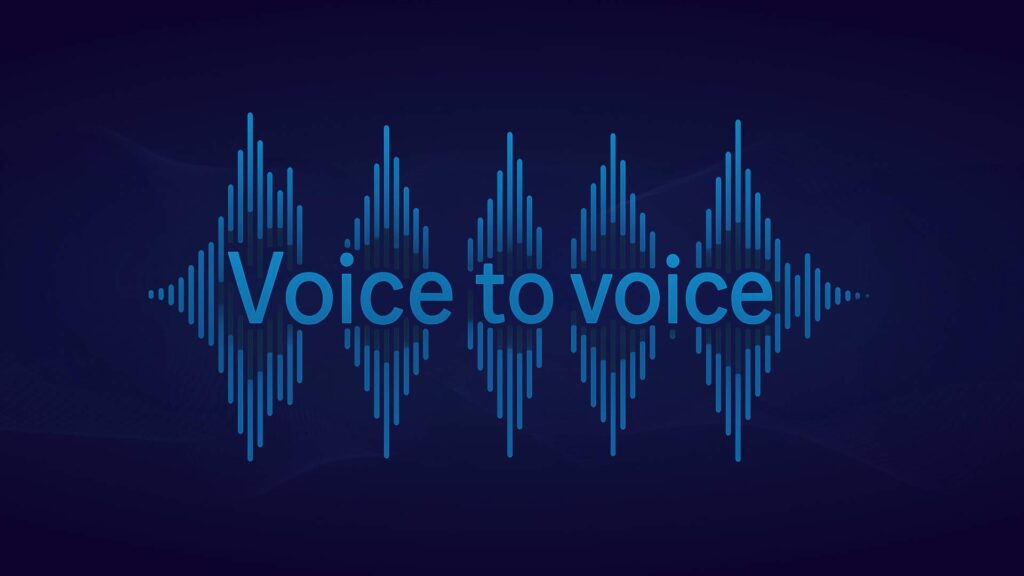Voice to Voice Technology: The Future of Communication Is Already Here
Voice to voice technology is making global communication easier, faster, and more human than ever before. Whether you’re working in healthcare, logistics, education, customer service, or even media—this innovation is helping people connect in real time, no matter what language they speak or where they are in the world. It’s eliminating confusion, speeding up collaboration, and creating more inclusive, accessible experiences for users everywhere.
In this blog, we’re sharing what voice to voice technology really is, how it works, where it’s already making an impact, and why it matters for businesses like yours today—and in the future.

What Is Voice to Voice technology?
Voice to voice technology is a system that can listen to what you say, understand it, and speak it back—often in a different language, tone, or voice. It combines several cutting-edge AI tools, including:
- Speech recognition – To convert your voice into text.
- Natural Language Understanding (NLU) – To figure out what you mean.
- Translation or transformation – To adapt the message to the target language or voice.
- Speech synthesis – To speak the message back, sounding as human and natural as possible.
This technology enables real-time, fluid conversations between people who speak different languages or have unique vocal needs. It’s like having a personal interpreter and voice mimic in your pocket—except it works instantly, doesn’t need coffee breaks, and keeps improving the more you use it.
So what’s the purpose?
The main goal is to make spoken communication seamless—across languages, cultures, devices, and even noise levels. Whether you’re trying to train a team, guide a customer, or collaborate internationally, voice to voice technology helps make it happen without friction. It breaks down communication barriers in real time, making global interactions smoother and more natural.
From enhancing customer support to enabling cross-border teamwork, the technology empowers people to connect, understand, and respond faster and more effectively. It’s not just about talking—it’s about truly being heard, understood, and able to engage without missing a beat.
How Does Voice to Voice Technology Work?
At a glance, voice-to-voice technology might seem like magic—but there’s a lot of sophisticated tech working behind the scenes to make it feel so seamless. Here’s a simple breakdown of the process.
First, you speak. Your voice is captured through a microphone or device, even in challenging environments like noisy factory floors or during mobile tasks like deliveries. Modern systems are built to handle real-world conditions. Then, your speech is recognized. Advanced voice recognition models—trained on massive datasets—convert your spoken words into text with impressive accuracy.
The system then interprets what you meant. This is where natural language understanding (NLU) comes in, analyzing your intent, context, and sometimes even your tone to figure out exactly what you’re trying to communicate. Once that’s clear, the AI translates or transforms your message. This could mean converting it into another language, adapting it to a specific dialect, or even rephrasing it in a different voice style.
Finally, the system speaks back. Using a synthetic voice—sometimes even one that sounds like you—it delivers the transformed message aloud in a smooth, natural way. And here’s the best part: it all happens in real time. The process is fast enough to feel like a normal back-and-forth conversation.
It might sound complex, but with the right tools—like aiOla—it’s as easy and intuitive as talking to a coworker.
Where Is Voice to Voice Technology Used?
You’d be surprised at how many industries are already using this tech—or could benefit from it. Let’s dive into a few of them:
- Tourism & Travel: Travelers can get real-time help, translations, or guided tours in their native language—no human translator required.
- Customer Service: Support agents can communicate with customers in any language, instantly. The system handles translation, while the agent focuses on solving the issue.
- Education: A single teacher can teach students who speak multiple languages. This tech also helps make education more accessible for students with disabilities.
- Business: Global teams can work together seamlessly, even if they don’t share a common language. Everyone hears the conversation in real time, in their own language.
- Media Production and Dubbing: Content creators can instantly dub audio or video into multiple languages while keeping the emotion and tone of the original speaker
- Healthcare: Doctors and patients can communicate clearly—no interpreter needed. This can be life-saving in emergency situations where time is everything.
Examples of Voice to Voice Technology in the Wild
You’ve likely come across voice-to-voice technology without even realizing it. Today, most major large language model (LLM) platforms offer some form of conversational mode, allowing users to interact with AI using spoken language. These tools are becoming more common—and more powerful—by the day.
For instance, Google Translate’s Conversation Mode lets you speak into your phone and instantly hear your sentence translated and spoken aloud in another language. Apple’s Siri combined with the Translate feature does something similar—ask Siri to translate a phrase, and she’ll speak it back to you on the spot.
Then there are more playful examples like celebrity voice changer apps, which have gone viral on platforms like TikTok. While they’re entertaining, they’re also powered by serious voice transformation technology.
And of course, there’s aiOla. Unlike basic translation tools, aiOla takes voice-to-voice tech further by enabling real-time, voice-first automation—purpose-built for fast-moving, high-stakes industries like logistics, field operations, and healthcare.
What Are the Benefits of Voice to Voice Technology?
There are some serious upsides to this tech—especially when it’s used to boost business operations. Here are a few of the biggest benefits:
- Breaks Language Barriers: No more delays, misunderstandings, or relying on bilingual staff. Everyone can communicate naturally, even if they don’t share a common language.
- Improves Accessibility: Voice interfaces help people with visual or motor impairments navigate systems, complete tasks, and stay connected—hands-free.
- Saves Time and Money: Think about it—No need to hire interpreters, schedule multilingual meetings, or waste time clarifying things. Everything flows in real time.
- Personalization: Voice technology can adjust to different dialects, mimic specific voices, or even match the tone of your brand. It makes every interaction feel more human.
- Better Human-Computer Interaction: People don’t want to click buttons or type commands—they want to talk. Voice interfaces powered by AI feel more intuitive, more natural, and more efficient.
- Enhances Customer Experience: Instant, voice-based support in any language can make users feel heard, valued, and understood—leading to greater satisfaction and loyalty.
- Supports Multitasking: Voice interactions allow users to complete tasks while driving, cooking, or working—perfect for staying productive on the go.
What Are the Challenges of Voice to Voice Technology?
As with any tech, there are some hurdles we still need to clear, such as:
- Accuracy & Accents: Understanding multiple dialects, slang, or heavy accents can be tricky—especially when context matters. Systems are improving, but it’s not perfect yet.
- Real-Time Performance: For voice to voice to feel natural, it has to be fast. A few seconds of lag can ruin the experience. That’s why speed and reliability are key.
- Privacy & Security: Your voice is data. If that data isn’t stored securely, it could be misused. Any business using voice to voice tech needs to think carefully about privacy policies.
- Ethics & Deep Fakes: Voice cloning can be powerful—but dangerous if misused. We’ve all seen deep fake videos and voice scams. Responsible use matters.
- Tech Requirements: Some voice to voice systems need serious processing power or stable internet. If your teams are working in the field or on the go, your tools need to keep up.
- Cultural Sensitivity: Language is more than words—it’s tone, gesture, and social context. Misinterpreting cultural nuances can lead to confusion or offense, even if the translation is technically correct.
- User Adoption: Not everyone is comfortable talking to machines. Training, trust, and a user-friendly design are essential for getting teams and customers to actually use the tech.
- Understanding Specific Jargon: Many systems struggle with industry-specific terms and acronyms, often requiring tedious training. aiOla solves this by understanding complex jargon automatically, without any extra effort or training.
Final Thoughts: Is Voice to Voice Right for You?
As you can see, voice to voice technology allows for real-time, spoken communication across languages, devices, and environments. If your business involves people talking—whether it’s with customers, teammates, or systems—voice to voice technology can make those conversations smoother, faster, and more powerful. It breaks down language barriers, improves accessibility, and saves time, though it also comes with challenges like maintaining accuracy, ensuring privacy, and meeting technical demands.
At aiOla, we’re building tools that bring this tech into the real world. From voice-powered automation to multilingual workflows, we help businesses go hands-free, real-time, and future-ready.







